If you are interested in joining us, as a student or a postdoc, please e-mail Chris (chris.lorenz@kcl.ac.uk) in order to discuss the potential for doing a certain project. There are numerous problems that we are interested in investigating, some of which are outlined on the Research page, Here are four specific projects that are indicative of some of the future areas we are interested in having a student work:
If you are interested in any of the above topics, please go ahead and apply directly to the Department of Physics at King’s College London by completing the application form found on this page.
Also we are involved in the following Ph.D. projects offered as part of the London Interdisciplinary Doctoral Programme (LIDo) Doctoral Training Partnership and the Biological Physics Across Scales (BiPAS) Centre for Doctoral Training, please get in touch if you are interested in either of those programmes and Chris will send you more details.




